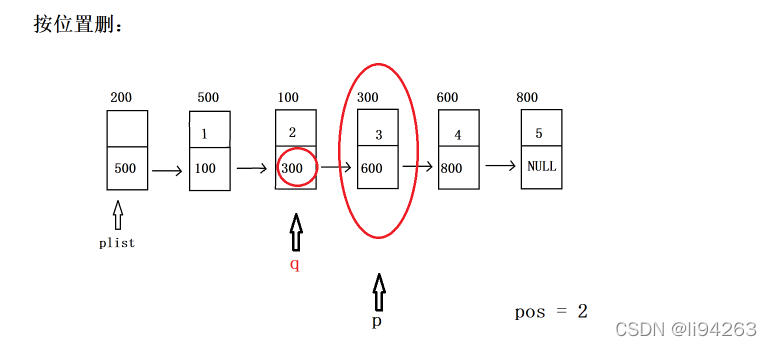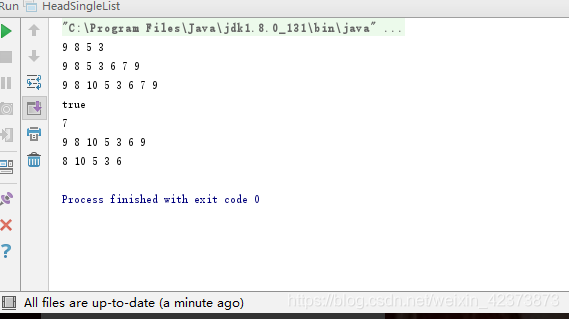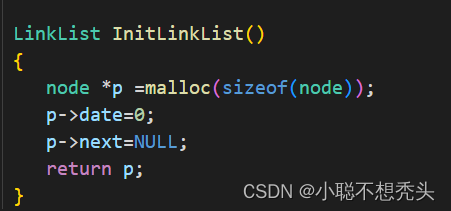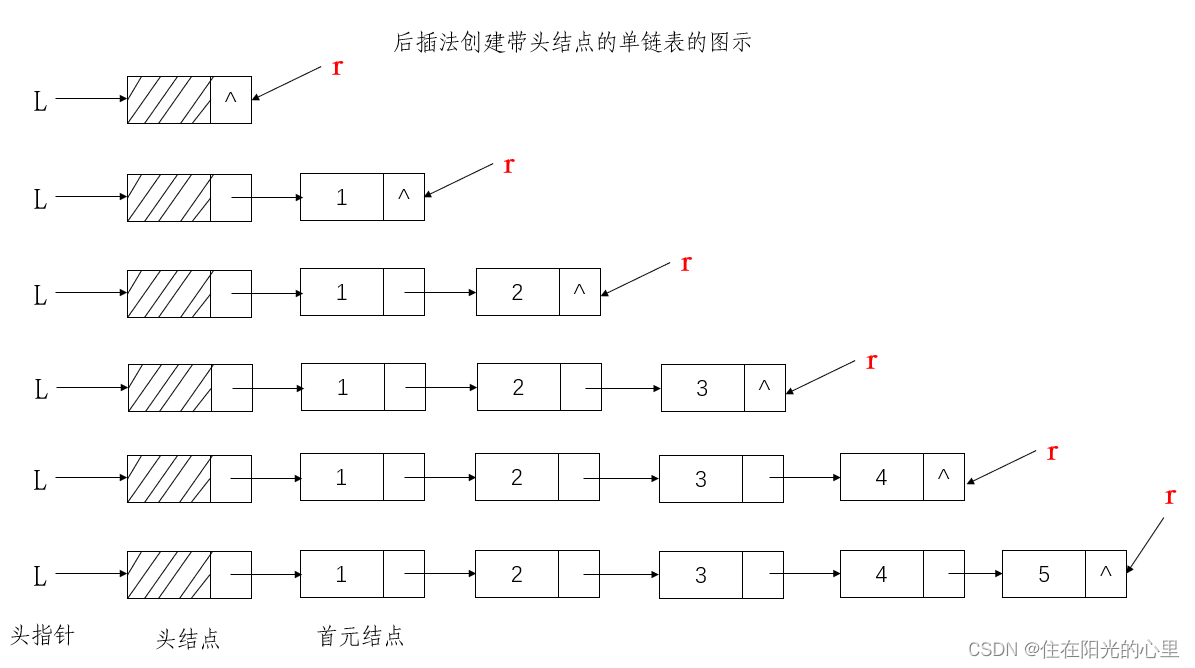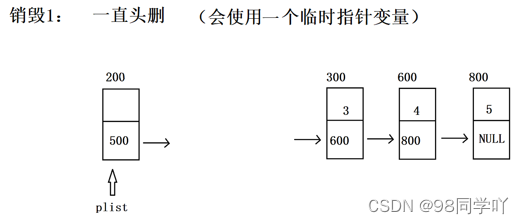单链表不带头结点结构体设计:
//不带头结点的结构体设计:
typedef int ELEM_TYPE;//有效数据节点结构体设计
typedef struct Node
{ELEM_TYPE data;//数据域 (1.头结点:不保存任何数据 2.有效数据节点:保存有效值) struct Node* next;//指针域 (1.头结点:保存第一个元素的地址 2.有效数据节点:保存下一个有效元素的地址)
}Node, * PNode;老规矩,实现链表的基本功能:增删改查
函数声明如下:
/初始化函数(对于头结点进行赋初值)
void no_head_Init_list(struct Node** phead);//struct Node ** == PNode *//购买一个新节点
struct Node* no_head_BuyNode(ELEM_TYPE val);//头插
bool no_head_Insert_head(PNode* phead, ELEM_TYPE val);//尾插
bool no_head_Insert_tail(struct Node** phead, ELEM_TYPE val);//按位置插入(pos=0 相当于头插 pos==length 相当于尾插)
bool no_head_Insert_pos(struct Node** phead, int pos, ELEM_TYPE val);//头删
bool no_head_Del_head(struct Node** phead);//尾删
bool no_head_Del_tail(struct Node** phead);//按位置删(pos==0 相当于头删 pos==length-1 相当于尾删(pos==length非法))
bool no_head_Del_pos(struct Node** phead, int pos);
//按值删
bool no_head_Del_val(struct Node** phead, ELEM_TYPE val);//获取值位置 (如果val值存在, 则返回其地址 不然返回NULL)
struct Node* no_head_Search(struct Node** phead, ELEM_TYPE val);//判空
bool no_head_IsEmpty(struct Node** phead);//判满 单链表不存在满这个概念//获取单链表有效数据节点个数
int no_head_Get_length(struct Node** phead);//清空 相当于直接调用销毁
void no_head_Clear(struct Node** phead);//销毁1(malloc申请来的空间 全部释放掉)
void no_head_Destroy(struct Node** phead);//销毁2
void no_head_Destroy2(struct Node** phead);//打印
void no_head_Show(struct Node** phead);对于函数括号里面的参数为什么是二级指针呢?由于该单链表没有头结点,所以我们需要一个指针来指向第一个有效节点,那么为了能使函数内部的改变能够影响外部数据,所以需要传参数时传入二级指针。

1.初始化
void no_head_Init_list(struct Node** phead)//struct Node ** == PNode *
{//assert phead!=NULLassert(phead != NULL);*phead = NULL;//修改一个指针,如果没有有效节点的话,将其指针指向NULL//这个指针保存第一个有效数据节点的地址 phead *phead(保存的第一个有效数据的地址) (*phead).next
}2.申请一个新节点便于插入
struct Node* no_head_BuyNode(ELEM_TYPE val)
{struct Node* pnewnode = (struct Node*)malloc(1 * sizeof(struct Node));assert(pnewnode != NULL);if (pnewnode == NULL){return NULL;}pnewnode->data = val;pnewnode->next = NULL;return pnewnode;
}
3.头插
bool no_head_Insert_head(PNode* phead, ELEM_TYPE val)
{//assertassert(phead != NULL);if (NULL == phead){return false;}//1.创建新节点struct Node* pnewnode = (struct Node*)malloc(1 * sizeof(struct Node));assert(pnewnode != NULL);pnewnode->data = val;pnewnode->next = NULL;//2.找到合适的插入位置 (头插函数 已经找到插入位置)//3.插入pnewnode->next = *phead;*phead = pnewnode;return true;
}4.尾插
bool no_head_Insert_tail(struct Node** phead, ELEM_TYPE val)
{assert(phead != NULL);if (no_head_IsEmpty(phead))//如果我是一个空链,则执行头插函数 不要执行尾插函数{return no_head_Insert_head(phead, val);}//1.创建新节点PNode pnewnode = (PNode)malloc(sizeof(Node) * 1);assert(pnewnode != NULL);pnewnode->data = val;pnewnode->next = NULL;//2.找到合适的插入位置PNode p = *phead;for (p; p->next != NULL; p = p->next);//这里存在一个bug:如果是空链的话,*phead == p == NULL,那么语句2:p->next会报写入异常(在上面处理一下这个bug即可)//此时 指针p停留在尾结点,而不是尾结点的下一个节点p->next = pnewnode;return true;
}5.按位置插
//按位置插入(pos=0 相当于头插 pos==length 相当于尾插)
bool no_head_Insert_pos(struct Node** phead, int pos, ELEM_TYPE val)
{assert(phead != NULL);assert(pos >= 0 && pos <= no_head_Get_length(phead));//pos == length合法 相当于尾插 但是这个位置不能用于删除if (pos == 0){return no_head_Insert_head(phead, val);}//1.购买新节点PNode pnewnode = no_head_BuyNode(val);assert(pnewnode != NULL);//2.找到合适的位置PNode p = *phead;for (int i = 1; i < pos; ++i)//这里存在一个bug:如果pos = 0,p没有办法跑到合适的位置,提前处理掉即可{p = p->next;}//3.插入pnewnode->next = p->next;p->next = pnewnode;return true;
}6,。头删
bool no_head_Del_head(struct Node** phead)
{assert(phead != NULL);if (no_head_IsEmpty(phead))//如果是空链,返回假{return false;}struct Node* p = *phead;*phead = p->next;free(p);return true;
}7.尾删(不带头结点的单链表尾删较为麻烦,会有两种风险)
bool no_head_Del_tail(struct Node** phead)
{assert(phead != NULL);//两种风险 第一种:q有可能为NULL(由于空链导致)if (no_head_IsEmpty(phead)){return false;}//什么情况下:q不为NULL,但是q->next为NULL? //有节点,但是仅有一个节点//两种风险 第二种:q->next有可能为NULL(由于导致)if ((*phead)->next == NULL) //仅有一个首元素节点{return no_head_Del_head(phead);//仅有一个节点,尾删和头删没区别}PNode q = *phead;for (q; q->next->next != NULL; q = q->next);//q向后一次项探测两步(有bug风险:1.p可能为NULL 2.p->next为NULL)//此时q停在倒数第二个节点(尾删的待删除节点的上一个节点)struct Node* p = q->next;//p通过q来直接指向待删除节点q->next = p->next;free(p);return true;
}8.按位置删
//按位置删(pos==0 相当于头删 pos==length-1 相当于尾删(pos==length非法))
bool no_head_Del_pos(struct Node** phead, int pos)
{assert(phead != NULL);assert(pos >= 0 && pos < no_head_Get_length(phead));if (no_head_IsEmpty(phead))//判空{return false;}if (pos == 0){return no_head_Del_head(phead);}struct Node* q = *phead;for (int i = 1; i < pos; i++){q = q->next;}struct Node* p = q->next;q->next = p->next;free(p);return true;
}9.按值删
bool no_head_Del_val(struct Node** phead, ELEM_TYPE val)
{assert(phead != NULL);if ((*phead)->data == val)//判断首元素的值 如果 == val{return no_head_Del_head(phead);}PNode p = no_head_Search(phead,val);if (p == NULL){return false;}PNode q = *phead;for (q; q->next != p; q = q->next);;//存在一个bug:如果要删除的值就是首元素的值,这时,q没有合适的位置去指向,所以在开头加上处理//此时 p指向待删除节点//q应该指向p的上一个节点q->next = p->next;free(p);return true;
}10.获取值得位置
//获取值位置 (如果val值存在, 则返回其地址 不然返回NULL)
struct Node* no_head_Search(struct Node** phead, ELEM_TYPE val)
{assert(phead != NULL);for (struct Node* p = *phead; p != NULL; p = p->next){if (p->data == val){return p;}}return NULL;
}11.判空
12.获取单链表有效节点的个数
//判空
bool no_head_IsEmpty(struct Node** phead)
{assert(phead != NULL);return (*phead) == NULL;
}//判满 单链表不存在满这个概念//获取单链表有效数据节点个数
int no_head_Get_length(struct Node** phead)
{assert(phead != NULL);int cout = 0;for (PNode p = *phead; p != NULL; p = p->next){cout++;}return cout;
}
13.清空、销毁、打印(销毁给出两种方法)
//清空 相当于直接调用销毁
void no_head_Clear(struct Node** phead)
{no_head_Destroy(phead);
}//销毁1(malloc申请来的空间 全部释放掉)
void no_head_Destroy(struct Node** phead)
{assert(phead != NULL);while (*phead != NULL){PNode p = (*phead);*phead = p->next;free(p);}*phead = NULL;
}//销毁2
void no_head_Destroy2(struct Node** phead)
{assert(phead != NULL);struct Node* p = *phead;struct Node* q;*phead = NULL;while (p != NULL){q = p->next;free(p);p = q;}
}//打印
void no_head_Show(struct Node** phead)
{assert(phead != NULL);for (PNode p = *phead; p != NULL; p = p->next){printf("%d ", p->data);}printf("\n");
}接下来在主函数里测试一下
int main()
{struct Node* head;//头指针no_head_Init_list(&head);//初始化for (int i = 0; i < 20; i++){no_head_Insert_pos(&head, i, i + 1);}//将1到20分别按位置插入no_head_Show(&head);//打印no_head_Insert_head(&head, 100);//头插100no_head_Insert_tail(&head, 200);//尾插200no_head_Show(&head);//打印printf("length = %d\n", no_head_Get_length(&head));//打印单链表有效数据节点的长度no_head_Del_head(&head);//头删no_head_Del_tail(&head);//尾删no_head_Show(&head);//打印no_head_Del_pos(&head, 4);//将第4个有效节点删除no_head_Del_val(&head, 14);//将数据为14的节点删除no_head_Show(&head);//打印printf("length = %d\n", no_head_Get_length(&head));//打印单链表有效数据节点的长度//Destroy(&head);no_head_Destroy2(&head);//销毁//printf("%d\n", sizeof(struct Node));return 0;
}结果:

